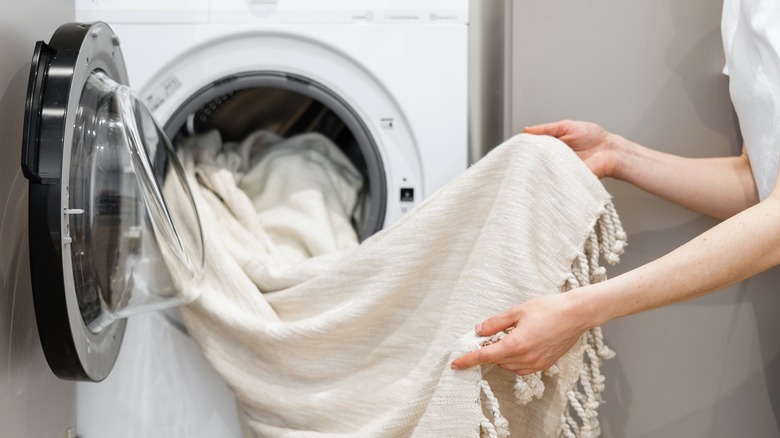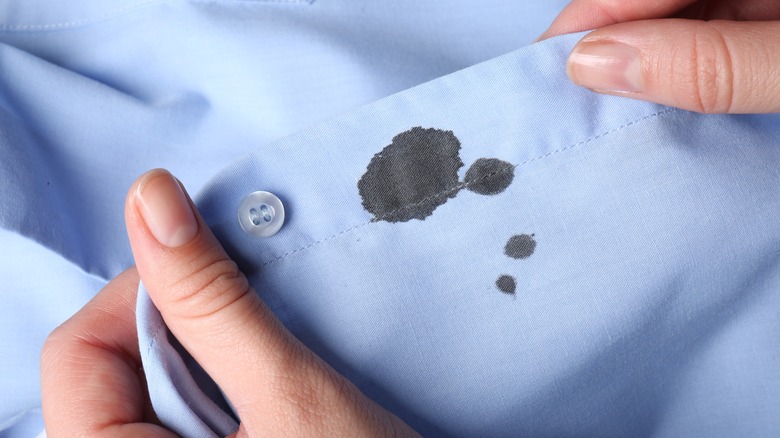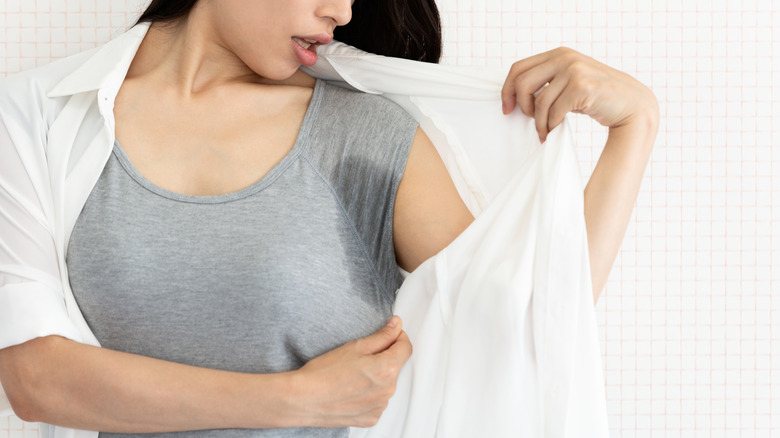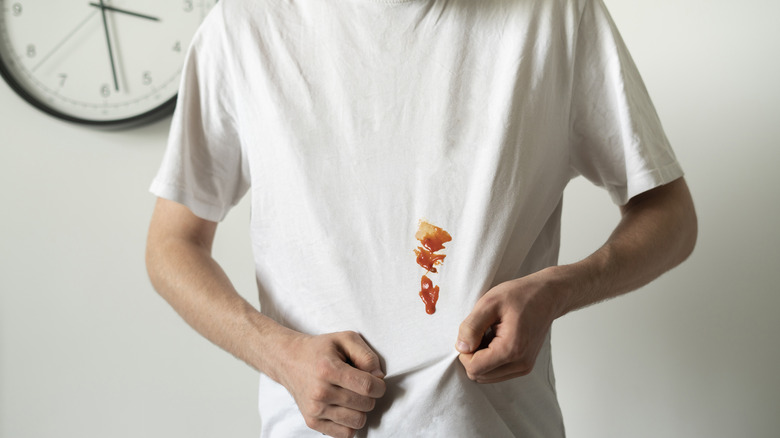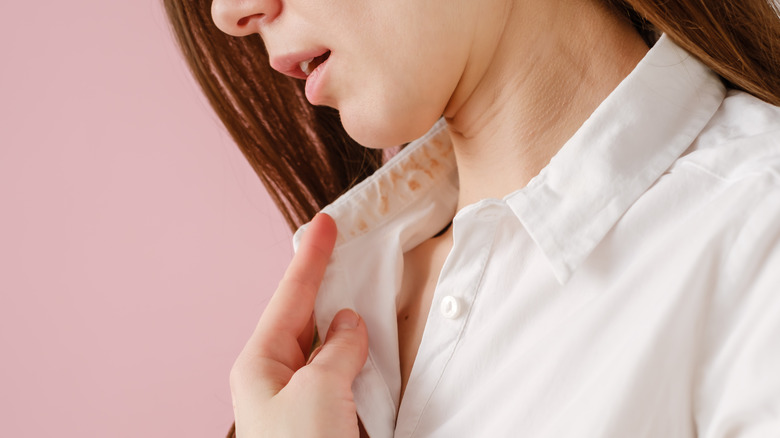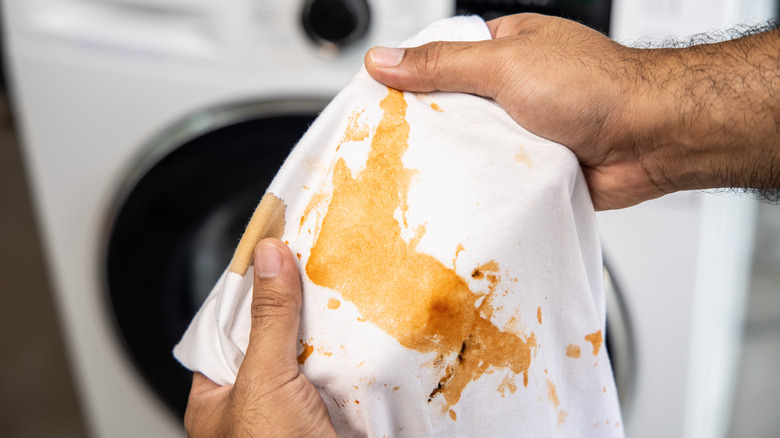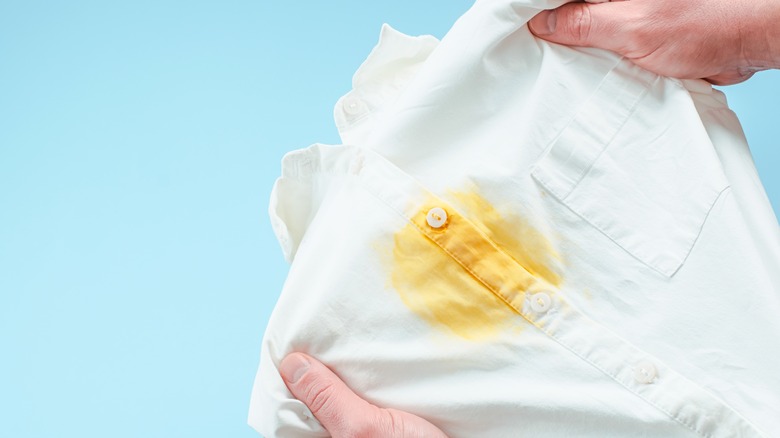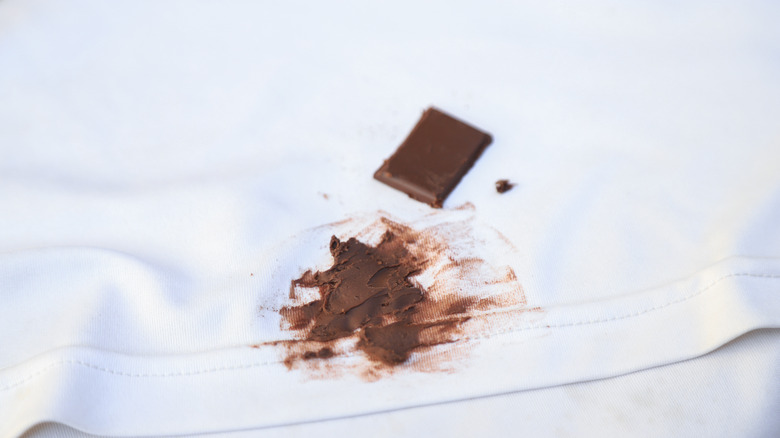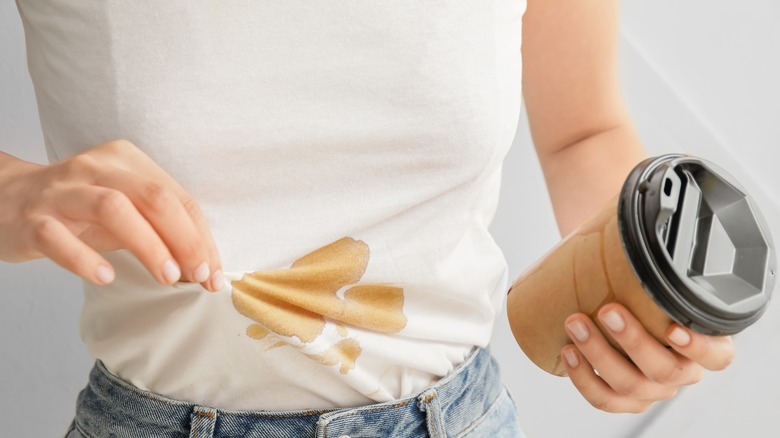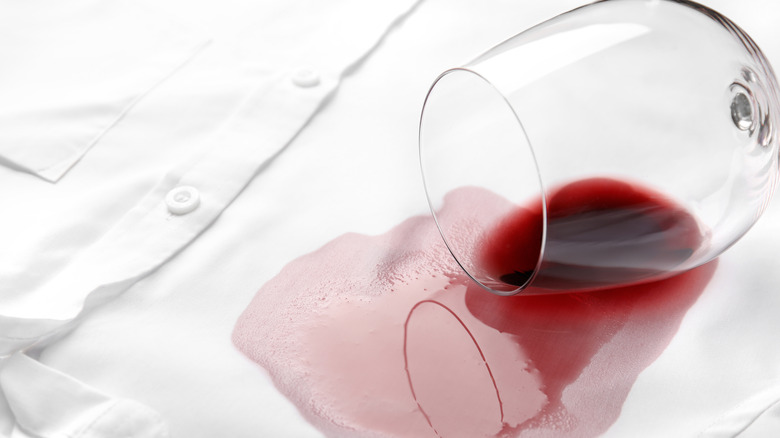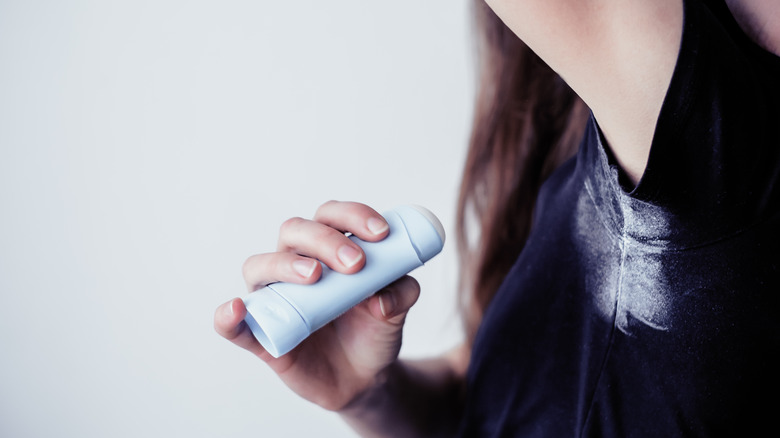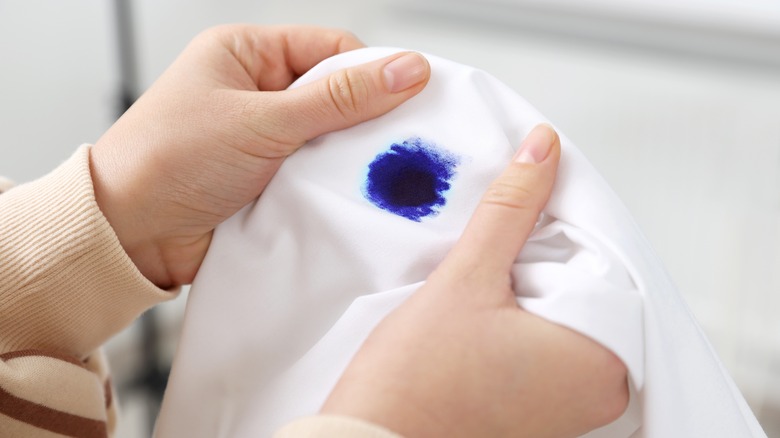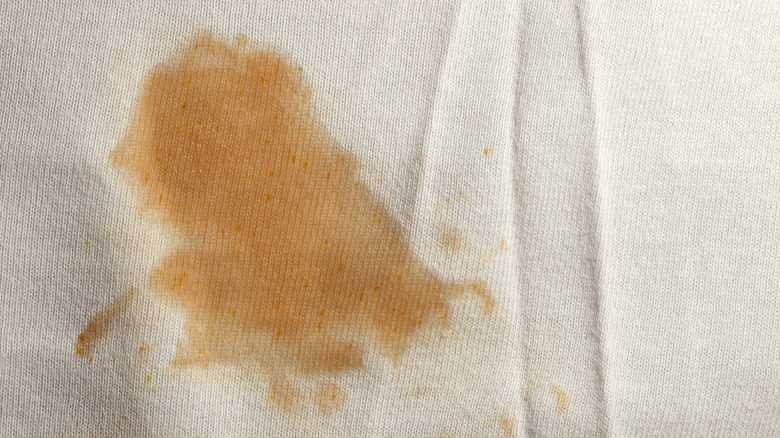12 Of The Toughest Laundry Stains & How To Get Them Out
When it comes to laundry stains, there is never a one-and-done magic product that can treat every type of stain you are likely to encounter. For some of the more common and tough-to-get-out ones, a few different methods, including making your own DIY spot remover, have been tested over the years and can have your clothes looking brand new again.
With most clothing items, you don't want to ever stick something still showing a stain into the dryer, as that is more likely to bake it in and make it even harder to remove. You also want to take into account the type of material you're dealing with — while something may work perfectly for removing a stain on, say, a cotton shirt, it may damage a more delicate fabric. Always look at the washing tag on your clothes before you attempt to differ from your usual laundry cycle. To help you tackle the toughest of stains, here are some proven methods to get rid of them.
Get rid of ink stains with cream of tartar
While ink stains are becoming less prevalent as the digital world advances, they certainly do still happen, and the scarcity of their occurrence means that you may not readily know how to get them out. If you happen to be a baker, you may just have the solution sitting on hand for your pesky ink blot: cream of tartar.
Cream of tartar is usually used in egg white-related recipes, like meringue, but can also be used as a pre-wash treatment to get ink out in a few simple steps. First, place a barrier, such as a towel, inside the shirt to prevent the stain from bleeding from one side onto the other. With that out of the way, you're ready to make your cream of tartar mix. Squeeze half a lemon into a bowl alongside 1 to 2 tablespoons of cream of tartar, mix into a paste, then apply it on the stain. You should let it rest, preferably for three hours, and then you can put the shirt directly into the wash. If it doesn't come out completely the first time, you can repeat this process, but do not machine dry the clothing article in between treatments.
Remove sweat stains with lemon juice
Sweat stains are probably one of the most common woes your clothes encounter. There are countless methods for removing sweat stains, but sometimes even the usual answers fail to totally clean your clothes. If you've already tried other ways to get rid of them, like mixing dish soap and hydrogen peroxide, it may be time to move on to a lemon.
Lemons are acidic, which can greatly help with stain removal. To use it as a laundry aid, combine one part lemon juice with one part water, and soak the stain for at least half an hour. For clothes that can stand up to scrubbing, you can even use a halved lemon with a nice coating of fine salt to scrub the stain out. Let the clothing air dry before you put it in to wash, but be wary of letting it lay uncovered in the sun, as it could become sun-bleached. After the lemon juice has dried, send it through the wash.
Say goodbye to sauce stains using baking soda
Food stains, and most specifically sauce, can be a major pain to get out, especially when they are very pigmented. Next time you get pasta sauce on your shirt, don't panic; instead, try rubbing the area with baking soda and salt. You're likely to have both on hand at home, so this is great for fast action.
If it's a fresh stain, gently dab off any remaining sauce, and rinse with cool water first. For older stains, you can skip straight to making yourself a paste. You'll need equal parts baking soda and salt, and a tiny bit of water. Mix the three ingredients together until you have a paste, then rub it into the stain. Rinse and repeat as needed. For tougher stains, you can let the paste sit and soak in for a little bit before attempting to do any scrubbing. Once you're finished, throw it into the wash like usual, and be sure to check that the stain is completely gone before putting it in the dryer.
Remove makeup stains using shaving cream
The best kind of makeup is the one that sticks, but that can have the unfortunate consequence of staining the fabrics it comes into contact with. Lipstick, mascara, foundation, and just about anything else you might apply to your face can end up on your shirt during application or throughout the day, and removing the marks can be a chore.
That's where shaving cream comes in. Shaving cream breaks up oil, which is exactly what is seeping into your clothes to create a stain. The best method of attack is to try to get the stain out before it goes through the wash to begin with. Any shaving cream will do; simply squirt a few dots onto the stain and let it set for 10 to 20 minutes, giving it time to soak in and break up oils. Then, dab the cream away with a towel and rinse the shirt with cool water. Once you've finished this process, go ahead and put the garment in to wash — just don't continue to rub or scrub the shirt as you could just be pushing the makeup deeper into the material.
Nix food stains with Windex
Multi-use cleaners are some of the best in terms of usefulness, but there certainly aren't many that you would consider for your laundry. We know fabric softener is great to clean walls, but a household cleaner that you can use on clothing stains? We're intrigued. Windex, surprise surprise, fits the bill.
Food stains can be removed from your clothing by spraying them with Windex, leaving it to soak for around 20 minutes, and then rinsing with cool water. You'll want the clear Windex instead of the blue, or else you could actually stain your clothes blue in the process. The ammonia in Windex helps to remove stains, but if it needs a little more help, you can gently rub and blot the area with a rag. It's especially important that you wash the clothes you treat with Windex once you're done, as you should never wear clothing that has any sort of cleaning chemical on it.
Get oil out with chalk
Oil can be one of the trickier things to clean up, especially in the form of clothing stains. It seems that no matter how many times you put an oil-stained piece of clothing through the wash, it never comes out clean. When all else fails, try blackboard chalk, preferably in white so that you're not rubbing pigments into your clothes and creating another problem area.
First, blot the oil with a paper towel, especially if the stain is fresh. Then, get to work with the chalk, lightly covering the entire stain; but don't crush the chalk into the fabric, or you could push the oil further in. You should also put a barrier, like a towel, between the layers of the clothing, so as not to transfer the stain. Let the chalk sit for at least 10 minutes so that it has time to absorb the oil. You can add stain remover or rub a bit of detergent into the spot afterward, especially if it's a tougher stain. To wash, you'll want to use hot water, but be sure to check the washing instructions on your clothes to make sure higher water temperatures won't ruin the garment.
Chocolate stains can come out with help of soda water
Chocolate stains are also notoriously hard to remove once they've set in, especially if you've accidentally let chocolate candy melt into your clothes. Don't despair over your children's Sunday best after the next holiday; O-Cedar has a hack to get it out.
As with other stains, if it's fresh, make sure to gently scrape away any excess chocolate remaining before you get to work; but don't rub it in during this step, or you'll make the stain worse. With the area as chocolate-free as possible, start flushing the chocolate out with cold water, running the water through the clean side of the fabric. Next, gently rub laundry detergent into the stain. Here's where the soda water comes: Let your garments soak in cold soda water for 15 minutes, rubbing it gently every three to five minutes. You can repeat these steps as needed, and once you're done, wash the item like usual.
Use vinegar to remove coffee stains
Coffee may be a lovely color to capture in a picture for you social media, but it's better kept in a cup than it is on your clothes. When it does inevitably leave a few drips on you, there are a few ways to remove the stains. One of these is to create a DIY stain-remover from a household favorite: vinegar.
This stain remover requires 1 quart of warm water, a 1/2 teaspoon of liquid dish soap, and 1 tablespoon of white vinegar. Mix the solution in a plugged sink or bucket, and then dunk your stained clothing item inside. Make sure it's fully submerged and saturated, and then leave it to soak for at least 15 minutes. Next, rinse with warm water, and if the stain has been successfully removed, wash the item. If not, you may want to take another few passes at removing the stain completely before moving on to the washer.
Get rid of red with hydrogen peroxide
Whether it is blood or red wine, red stains tend to stick around despite our best efforts. Hydrogen peroxide, however, can usually be used to get that stubborn hue out once and for all. With blood, hydrogen peroxide may make a slight fizzing noise and bubble — this only means that it is working. For wine stains, you will want to use a mixture of hydrogen peroxide and dishwashing liquid together in a three-to-one ratio, with hydrogen being the greater of the two.
In either case, let the hydrogen peroxide soak for a bit — 20 minutes at least — and then blot the fabric before rinsing it in cool water. With both, don't scrub to get the stain out; dabbing, light rubbing, and blotting are the best approach. You may want to use gloves when working with hydrogen peroxide, as it can irritate your skin.
Get deodorant stains out with tights
To get deodorant off your clothes, you won't need to do soaking, find special ingredients, or even get the shirt wet — all you need for this deodorant stain removal hack is a pair of tights or pantyhose. Simply rub the tights over the stained area; the texture will help to pull the stain out without damaging your shirt. You should gently rub in a circular motion. It may take some time, but time and patience over excessive force will ensure your success.
With this method, any residue left over from deodorant should come up and unbound from the fabric. You will likely notice a difference in the feeling of the shirt once the deodorant is gone too, even if it's not fully washed yet. Once you've taken out as much as you can, add the shirt to the wash like usual, and feel free to apply a little stain remover if the mark is persistent.
Milk makes permanent marker stains disappear
The "permanent" part of permanent marker may make you think there's no going back, but if you have a marker stain, don't throw in the towel just yet. You'll need a lot of milk for this hack, but if the item of clothing you've stained is valuable to you, then it's worth it.
First, you'll need a basin. This can be a bucket, container, bowl, or plugged sink — whatever will fit your stained item. Add in the item of clothing and then pour milk in until the stained portion of the cloth is completely submerged. You'll want to let it soak for a good while — at least five hours, or better yet, overnight. Once it has soaked for enough time, you can drain the milk and gently scrub the stain with a soft bristle brush, such as a toothbrush, with more milk. Do this until the mark is no longer as visible, and then immediately put it into the wash, as milk can stain your clothes if it's allowed to dry.
Say goodbye to rust-colored stains by using salt
Rust stains are another mesh of brown, orange, and red that just seem not to go away when you want them to. Sprinkling salt on the stain, or using salt to gently scrub it, works wonders, especially when used in combination with lemon juice. Similar in acidity to lemon juice is white vinegar, but no matter which you choose, salt is the top choice as the helper. For this hack to work, you should leave the stained clothing out to dry after scrubbing it or letting it soak, preferably in the sun. Though, to prevent sun bleaching, cover it with a towel or other thin barrier. Once it's dry, it will be ready to wash.
As with all stains and clothes, always check the tags and directions for cleaning before you attempt any DIY stain removal. Some methods may damage certain materials far more than the stain you're trying to remove. For less easy fabrics like silk or leather, or for expensive items, consider taking your stained item to a dry cleaner to have it professionally handled.
